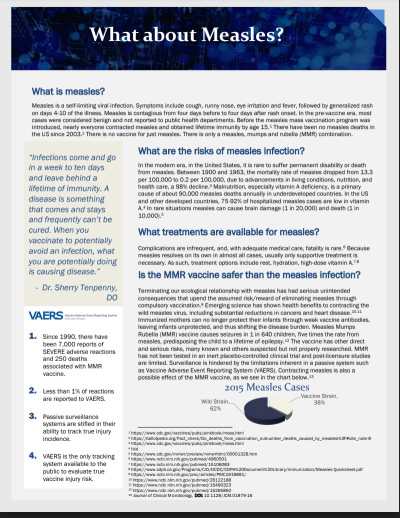What is measles?
Measles is a self-limiting viral infection. Symptoms include cough, runny nose, eye irritation and fever, followed by generalized rash on days 4-10 of the illness. Measles is contagious from four days before to four days after rash onset. In the pre-vaccine era, most cases were considered benign and not reported to public health departments. Before the measles mass vaccination program was introduced, nearly everyone contracted measles and obtained lifetime immunity by age 15.1 There have been no measles deaths in the US since 2003.2 There is no vaccine for just measles. There is only a measles, mumps and rubella (MMR) combination.
What are the risks of measles infection?
In the modern era, in the United States, it is rare to suffer permanent disability or death from measles. Between 1900 and 1963, the mortality rate of measles dropped from 13.3 per 100,000 to 0.2 per 100,000, due to advancements in living conditions, nutrition, and health care, a 98% decline.3 Malnutrition, especially vitamin A deficiency, is a primary cause of about 90,000 measles deaths annually in underdeveloped countries. In the US and other developed countries, 75-92% of hospitalized measles cases are low in vitamin A.4 In rare situations measles can cause brain damage (1 in 20,000) and death (1 in 10,000).5
What treatments are available for measles?
Complications are infrequent, and, with adequate medical care, fatality is rare.6 Because measles resolves on its own in almost all cases, usually only supportive treatment is necessary. As such, treatment options include rest, hydration, high-dose vitamin A.7,8
Is the MMR vaccine safer than the measles infection?
Terminating our ecological relationship with measles has had serious unintended consequences that upend the assumed risk/reward of eliminating measles through compulsory vaccination.9 Emerging science has shown health benefits to contracting the wild measles virus, including substantial reductions in cancers and heart disease.10,11 Immunized mothers can no longer protect their infants through weak vaccine antibodies, leaving infants unprotected, and thus shifting the disease burden.
Measles Mumps Rubella (MMR) vaccine causes seizures in 1 in 640 children, five times the rate from measles, predisposing the child to a lifetime of epilepsy.12 The vaccine has other direct and serious risks, many known and others suspected but not properly researched. MMR has not been tested in an inert placebo-controlled clinical trial and post-licensure studies are limited. Surveillance is hindered by the limitations inherent in a passive system such as Vaccine Adverse Event Reporting System (VAERS). Contracting measles is also a possible effect of the MMR vaccine, as we see in the chart.13
2015 Measles Cases
Vaccine Strain, 38% Wild Strain, 62%
“Infections come and go in a week to ten days and leave behind a lifetime of immunity. A disease is something that comes and stays and frequently can’t be cured. When you vaccinate to potentially avoid an infection, what you are potentially doing is causing disease.”
– Dr. Sherry Tenpenny, DO
VAERS Vaccine Adverse Events Reporting System
1. Since 1990, there have been 7,000 reports of SEVERE adverse reactions and 250 deaths associated with MMR vaccine.
2. Less than 1% of reactions are reported to VAERS.
3. Passive surveillance systems are stifled in their ability to track true injury incidence.
4. VAERS is the only tracking system available to the public to evaluate true vaccine injury risk.
1 https://www.cdc.gov/vaccines/pubs/pinkbook/meas.html
2 https://ballotpedia.org/Fact_check/Do_deaths_from_vaccination_outnumber_deaths_caused_by_measles%3F#cite_note-8
3 https://www.cdc.gov/vaccines/pubs/pinkbook/meas.html
4 Ibid
5 https://www.cdc.gov/mmwr/preview/mmwrhtml/00001328.htm
6 https://www.ncbi.nlm.nih.gov/pubmed/4960501
7 https://www.ncbi.nlm.nih.gov/pubmed/15106083
8 https://www.cdph.ca.gov/Programs/CID/DCDC/CDPH%20Document%20Library/Immunization/Measles-Quicksheet.pdf
9 https://www.ncbi.nlm.nih.gov/pmc/articles/PMC1919891/
10 https://www.ncbi.nlm.nih.gov/pubmed/26122188
11 https://www.ncbi.nlm.nih.gov/pubmed/16490323
12 https://www.ncbi.nlm.nih.gov/pubmed/15265850
13 Journal of Clinical Microbiology, DOI: 10.1128/JCM.01879-16
Download, print and share this flyer with your friends, family and community. Download Here
What-about-Measles-2019
